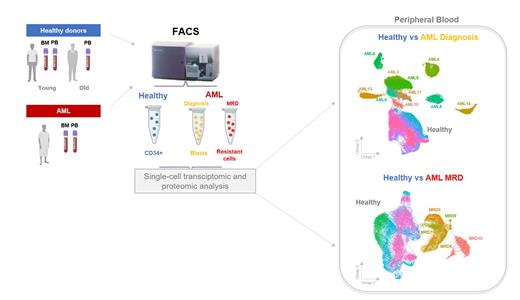BACKGROUNG: Multiparameter flow cytometry (MFC) is traditionally used to asses MRD in AML. However, its sensitivity and specificity lag behind other methods and this precludes a broader application in routine practice. It could be hypothesized the emerging multiomics such as single-cell RNA and antibody sequencing could uncover new differences from normal and leukemia associated immunophenotypes (DfN/LAIP). In addition, the identification of DfN/LAIP may be easier in PB when compared to the BM due to the scarcity of CD34+ HPC in the former sample.
AIM: Uncover new DfN/LAIP for improved MFC discrimination between normal CD34+ HPC and blasts in the BM and PB of AML patients.
METHODS: A total of 47 samples were analyzed in this study. Namely, paired BM and PB from 5 young healthy adults (20-23yo) and 5 PB samples from older healthy adults (47-88yo); paired BM and PB of 11 newly diagnosed AML (44-79yo) patients, and paired BM and PB collected in 5 of the 11 AML patients at the time of MRD assessment. We used fluorescence activated cell sorting (FACS) to isolate CD34+ HPC from the BM and PB of healthy adults as well as blasts from AML patients. scCITE-Seq with a panel of 600 genes and 50 oligo-conjugated antibodies, selected according to their role in stem cell identification, lineage differentiation, clonal hematopoiesis and aberrant expression in myeloid neoplasms was performed. After quality control filtering, a total of 111,334 cells were analyzed and differential expression of genes and antigens was considered if an adjusted P-value <.05 and a log 2FoldChange (FC) >|1| were observed.
RESULTS: We first analyzed the phenotype of paired BM and PB 32,637 CD34+ HPC from younger healthy adults. There were 82 deregulated genes, 50 overexpressed in BM and 32 in PB. CLEC12A, CEBPA and HBB were amongst the top overexpressed genes in BM, whereas CRHBP, ADGRG6 and MEIS1 showed the highest upregulation in PB. These results suggest partial transcriptional overlap between BM and PB CD34+ HPC, with the former showing reduced differentiation. There were no differences in antigen expression. Next, we analyzed the potential effect of aging in the phenotype of 34,102 CD34+ HPC from the PB of young and older healthy adults. There were 34 genes differentially expressed including BCORL1, CBLB, HRAS and KDM6A. These findings might reflect an upregulation of genes associated with clonal hematopoiesis. Furthermore, there were 13 antigens differentially expressed including CD9, CD10, CD33, CD38, CD62L and CD371.
The comparison of 56,387 blasts in paired BM and PB samples from newly diagnosed AML patients showed near overlap with only HBB being differentially expressed. There were no differences in antigen expression. We then investigated the extent of phenotypic differences between normal CD34+ HPC vs blasts in the BM and PB of healthy adult's vs AML patients. There were 224 and 15 differentially expressed genes between BM cell types, whereas in PB the numbers were 182 and 11, respectively. The markers that contributed the most in the discrimination between CD34+ HPC vs blasts in PB were WT1, ADM, HMOX1, DDIT3, HOPX, CD371, CD45RA, CD133 and CD47. The overlap between DfN/LAIP identified in PB and BM was 31%.
Four of the five patients monitored after treatment were MRD positive in BM using MFC. Of note, BM and PB CD34+ HPC isolated from the five AML patients (including one MRD negative in BM) clustered separately of normal BM and PB CD34+ HPC from healthy adults. There was near overlap between BM and PB cells from AML patients. The markers that contributed the most in the discrimination between PB CD34+ HPCfrom healthy adult's vs resistant cells from AML patients were CXCL16, LILRA5, MME, CD274, CTSL, MINPP1 and AHSP.
CONCLUSIONS: Normal CD34+ HPC in PB showed partial overlap with the BM counterpart, with a few phenotypic differences probably related to less differentiation and the effects of aging and clonal hematopoiesis. The phenotype of BM and PB blasts from newly diagnosed AML patients nearly overlapped, which indicates that DfN/LAIP may be equally applicable in BM and PB. Accordingly, the markers included in the scRNA/Ab-seq panel effectively discriminated CD34+ HPC from blasts regardless of the sample of origin. Furthermore, we showed phenotypic divergence between PB CD34+ HPC of healthy adults' vs AML patients after treatment. Taken together, this study identified new DfN/LAIP markers for improved assessment of MRD using MFC in the PB of AML patients.
Disclosures
Pierola:Syros: Consultancy, Speakers Bureau; Abbvie: Speakers Bureau; Jazz Pharma: Consultancy, Speakers Bureau; BMS: Consultancy, Speakers Bureau; Astellas: Consultancy; Astra Zeneca: Research Funding; Novartis: Speakers Bureau. Montesinos:Janssen: Speakers Bureau; Ryvu: Consultancy; NERVIANO: Consultancy; OTSUKA: Consultancy; Astellas: Consultancy, Speakers Bureau; INCYTE: Consultancy; Kura oncology: Consultancy; Menarini-Stemline: Consultancy, Research Funding; Jazz pharma: Consultancy, Research Funding, Speakers Bureau; Celgene: Consultancy; BEIGENE: Consultancy; GILEAD: Consultancy; Takeda: Consultancy, Research Funding; Novartis: Consultancy, Research Funding; Abbvie: Consultancy, Research Funding, Speakers Bureau; Pfizer: Consultancy, Research Funding, Speakers Bureau; BMS: Consultancy, Other, Research Funding; Daiichi Sankyo: Consultancy, Research Funding. Paiva:Roche Glycart AG: Honoraria, Research Funding; Amgen: Honoraria; Bristol-Myers Squibb: Consultancy, Honoraria, Research Funding; Janssen: Consultancy, Honoraria; Sanofi: Consultancy, Honoraria, Research Funding; EngMab: Research Funding; GSK: Honoraria, Research Funding; Takeda: Honoraria, Research Funding; Adaptive: Honoraria; Gilead: Honoraria; Oncopeptides: Honoraria.


